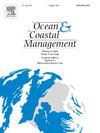评估物理距离和替代距离对陈述偏好的影响:一个来自中国海湾的选择实验案例
IF 5.4
2区 环境科学与生态学
Q1 OCEANOGRAPHY
引用次数: 0
摘要
空间距离是影响生态系统服务改善公众支付意愿的重要因素,明确空间距离对公众偏好和公众支付意愿的影响对提高价值评估的有效性至关重要。在此基础上,以中国胶州湾为例,将空间距离分为两类:被调查者居住地到胶州湾的物理距离和到最近替代海湾的替代距离。采用选择实验法(CE)收集了568名公众的调查数据,采用随机参数logit (RPL)模型分析了这两个距离变量对公众偏好和WTP的影响。结果表明:(1)公众对海湾景观功能和绿潮尺度的偏好和WTP表现出显著的物理距离衰减效应,具有明确的空间边界;(2)替代距离对海湾水体清澈度、景观功能和绿潮规模的偏好和WTP均有正向影响,表明替代资源可及性较低时存在代偿偏好机制;(3)不同社会群体的空间距离效应存在异质性,女性和高学历受访者的WTP对距离变化的响应更为稳定。这些发现证实了空间距离在形成环境偏好方面的关键作用,并为更好地将空间维度纳入环境干预措施的设计提供了政策启示。本文章由计算机程序翻译,如有差异,请以英文原文为准。
Assessing the impact of physical distance and substitute distance on stated preferences: a choice experiment case from a Chinese bay
Spatial distance is a crucial factor influencing the public's willingness to pay (WTP) for ecosystem services improvements, and clarifying its impact on preferences and WTP is essential for enhancing the validity of value assessments. Based on this, Jiaozhou Bay in China was taken as a case study, with spatial distance divided into two categories: the physical distance from respondents' residences to Jiaozhou Bay and the substitute distance to the nearest alternative bay. Research data from a survey of 568 members of the public were collected using a choice experiment (CE), and a random parameter logit (RPL) model was employed to analyze the impact of these two distance variables on public preferences and WTP. The results show that: (1) public preferences and WTP for bay landscape function and green tide scale exhibit a significant physical distance decay effect, with a clearly defined spatial boundary; (2) substitute distance has a positive effect on preferences and WTP for bay water clarity, landscape function, and green tide scale, indicating a compensatory preference mechanism when substitute resources are less accessible; and (3) spatial distance effects are heterogeneous across social groups, with female and highly educated respondents showing more stable WTP in response to distance variation. These findings confirm the critical role of spatial distance in shaping environmental preferences and offer policy implications for better integrating spatial dimensions into the design of environmental interventions.
求助全文
通过发布文献求助,成功后即可免费获取论文全文。
去求助
来源期刊

Ocean & Coastal Management
环境科学-海洋学
CiteScore
8.50
自引率
15.20%
发文量
321
审稿时长
60 days
期刊介绍:
Ocean & Coastal Management is the leading international journal dedicated to the study of all aspects of ocean and coastal management from the global to local levels.
We publish rigorously peer-reviewed manuscripts from all disciplines, and inter-/trans-disciplinary and co-designed research, but all submissions must make clear the relevance to management and/or governance issues relevant to the sustainable development and conservation of oceans and coasts.
Comparative studies (from sub-national to trans-national cases, and other management / policy arenas) are encouraged, as are studies that critically assess current management practices and governance approaches. Submissions involving robust analysis, development of theory, and improvement of management practice are especially welcome.
 求助内容:
求助内容: 应助结果提醒方式:
应助结果提醒方式:


